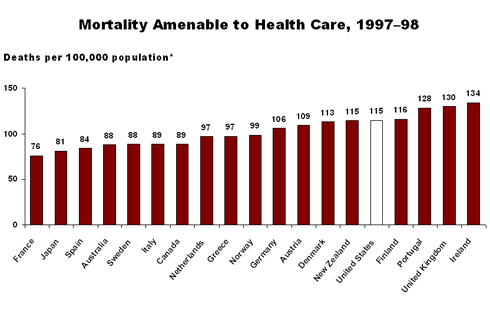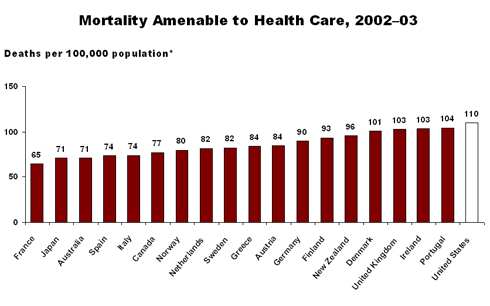Measuring the Health of Nations: Updating an Earlier Analysis
Ellen Nolte, Ph.D., and C. Martin McKee, M.D., D.Sc.
Health Affairs
January 8, 2008 | Volume 98
In the Literature
In a Commonwealth Fund-supported study comparing preventable deaths in 19 industrialized countries, researchers found that the United States placed last. While the other nations improved dramatically between the two study periods — 1997-98 and 2002-03 — the U.S. improved only slightly on the measure.
In “Measuring the Health of Nations: Updating an Earlier Analysis” (Health Affairs, Jan./Feb. 2008), Ellen Nolte, Ph.D., and C. Martin McKee, M.D., D.Sc., both of the London School of Hygiene and Tropical Medicine, compared international rates of “amenable mortality”–that is, deaths from certain causes before age 75 that are potentially preventable with timely and effective health care. In addition to the U.S., the study included 14 Western European countries, Canada, Australia, New Zealand, and Japan. According to the authors, if the U.S. had been able reduce amenable mortality to the average rate achieved by the three top-performing countries, there would have been 101,000 fewer deaths annually by the end of the study period.
The concept of amenable mortality was developed in the 1970s to assess the quality and performance of health systems and to track changes over time. For this study, the researchers used data from the World Health Organization on deaths from conditions considered amenable to health care, such as treatable cancers, diabetes, and cardiovascular disease.
U.S. Ranks Last
Between 1997–98 and 2002–03, amenable mortality fell by an average of 16 percent in all countries except the U.S., where the decline was only 4 percent. In 1997–98, the U.S. ranked 15th out of the 19 countries on this measure–ahead of only Finland, Portugal, the United Kingdom, and Ireland–with a rate of 114.7 deaths per 100,000 people. By 2002–03, the U.S. fell to last place, with 109.7 per 100,000. In the leading countries, mortality rates per 100,000 people were 64.8 in France, 71.2 in Japan, and 71.3 in Australia.
The largest reductions in amenable mortality were seen in countries with the highest initial levels, including Portugal, Finland, Ireland, and the U.K, but also in some higher-performing countries, like Australia and Italy. In contrast, the U.S. started from a relatively high level of amenable mortality but experienced smaller reductions.
Many Lives in U.S. Could Be Saved
The researchers estimated the number of lives that could have been saved in 2002 if the U.S. had achieved either the average of all countries analyzed (except the U.S.) or the average of the three top-performing countries. Using this formula, the authors estimated that approximately 75,000 to 101,00 preventable deaths could be averted in the U.S. “[E]ven the more conservative estimate of 75,000 deaths is almost twice the Institute of Medicine’s (lower) estimate of the number of deaths attributable to medical errors in the United States each year,” the authors say.
Future Implications
The rate of amenable mortality is a valuable indicator of health care performance, say the authors–one that can point to potential weaknesses in a nation’s health system that require attention. “[T]he findings presented here are consistent with other cross-national analyses, demonstrating the relative underperformance of the U.S. health care system in several key indicators compared with other industrialized countries,” they say.


Citation: E. Nolte and C. M. McKee, Health Affairs, January/February 2008, 27(1):58-71